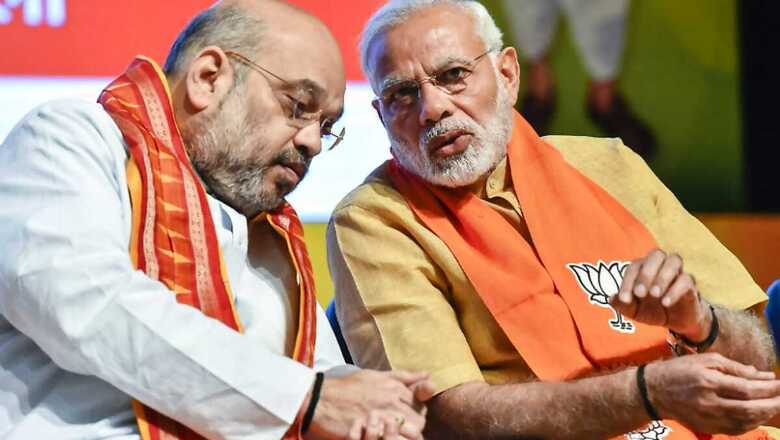
views
Twenty months into power in its second term, the National Democratic Alliance (NDA) under the leadership of Prime Minister Narendra Modi has witnessed a visible transformation. The BJP makes up more than 90 per cent of the NDA (302 of 334 Lok Sabha members), with just one minister of state from outside the BJP in the Union council of ministers.
Though it formally continues as an NDA government, all the ministers with cabinet rank belong to the BJP. When the present NDA government started its second term, three of the cabinet ministers and one minister of state hailed from the non-BJP NDA. Over the past 20 months, two of the cabinet ministers from outside the BJP resigned when their parties left the coalition and one passed away, and has not yet been replaced.
Today, the NDA officially consists of 19 parties of which 10 are represented in the Lok Sabha. When it returned to power after the 2019 Lok Sabha elections, the NDA consisted of 20 parties of which 10 were represented in the Lok Sabha. After the 2019 polls, it had 352 members of whom 303 belonged to the BJP (86%). What clearly has changed is the dominant presence of the BJP within the NDA and the fact that the Council of Ministers, save one Minister, is exclusively from the ranks of the BJP.
It would be useful to look at the nature and structure of the NDA in the past. When it first contested the elections as an alliance in 1998, it was a 14-party alliance. In the 1998 polls, the NDA won 251 seats of which the BJP accounted for 178 (71%). With the support of the TDP, it secured a majority and formed the government. In the 21 cabinet ministers in NDA government, 10 (nearly half) were from outside the BJP.
Six of the 21 ministers of state were from the partners of the BJP in the NDA. When elections were held the next year (1999) after the fall of the Atal Bihari Vajpayee-led NDA government by one vote, the NDA won 302 seats of which the BJP share was 182 (60%). There were now 21 parties in the NDA. Nine of the 21 cabinet ministers were from the partners of the BJP in the NDA. In both the Vajpayee-led NDA governments of 1998 and 1999, the non-BJP Ministers held key portfolios including Defence, Commerce, Railways, Law, Steel and Mines, Surface Transport and Power. Post 2014, the portfolios of non-BJP ministers included Food Processing, Consumer Affairs, Food and Public Distribution and Public Enterprises.
Earlier, coalition governments had also seen a minimal role for the key player within the coalition. When VP Singh from the Janata Dal led the five-party National Front government in 1989, it was supported from the outside by both the BJP and the Left parties. Within the National Front, the Janata Dal made up just over one fourth of the numbers in the Lok Sabha. Later in 1996, when the thirteen party United Front came to power with the outside support of the Congress, Prime Minister Deve Gowda’s Janata Dal made up less than one fourths of the coalition’s strength.
It would also be useful to recall that when the Congress-led UPA was in power for two terms from 2004 to 2014, The Congress made up 60 percent of the alliance in 2004 and 80 percent if the alliance in 2009. One fourth of the cabinet ministers in the UPA were from outside the Congress and held key portfolios, including Agriculture, Railways, Communications and Information Technology, Rural Development, Health and Family Welfare.
The above narration makes very clear three sets of issues. Firstly, the Narendra Modi-led NDA coalition is distinctly different from both the NDA coalitions led by Vajpayee as well as the United Front and National Front coalitions. In these earlier coalitions, the role of the major partner in the coalition was severely limited, ranging from being one fourth of the coalition to seventy percent of the coalition. The Modi-led NDA coalitions have seen the BJP constituting 90 percent of the NDA strength in the Lok Sabha.
Secondly, the composition of the council of ministers in the coalition has also seen a dramatic change. In the National Front, United Front, NDA (under Vajpayee) and UPA coalitions, it is often argued that the coalition partners not only decided who will represent them, they also bargained aggressively for both the numbers they would have and the portfolios that would be assigned. The Prime Minister had to yield to the pulls and pressure of the coalition.
After 2014, the story has been very different. The BJP has been very clear in terms of number of Cabinet berths that the coalition partners would get and also the portfolio they would be allotted. This was always a sore point for the Shiv Sena when it was part of the NDA. It would be useful to recall that the JD(U) refused to join the Cabinet in 2019 because they were unhappy with the number of positions offered.
Thirdly, ever since the BJP-led NDA returned to power after the 2019 elections, the BJP has further consolidated its position and for all practical purposes it is a BJP government. It is important to remember that the BJP preferred to continue with the coalition in 2014 even though they had secured a majority on their own. This gave the party an advantage in dealing with its coalition partners. In its second term, one has seen in the 20 months in office, the BJP placing on priority its key agenda relating to the abrogation of Article 370 and attempting to redefine the contours of politics in what was Jammu and Kashmir. With five coalition partners withdrawing from the NDA (Shiv Sena and Akali Dal being the key ones who also had representation in the Cabinet) the BJP has further consolidated its numbers and strength in the coalition. While the NDA coalition government is for all practical purposes a BJP government, it is just a matter of time that the BJP could well shed the cloak of the NDA and herald the end of three decades of coalition and minority governments.
Read all the Latest News, Breaking News and Coronavirus News here















Comments
0 comment